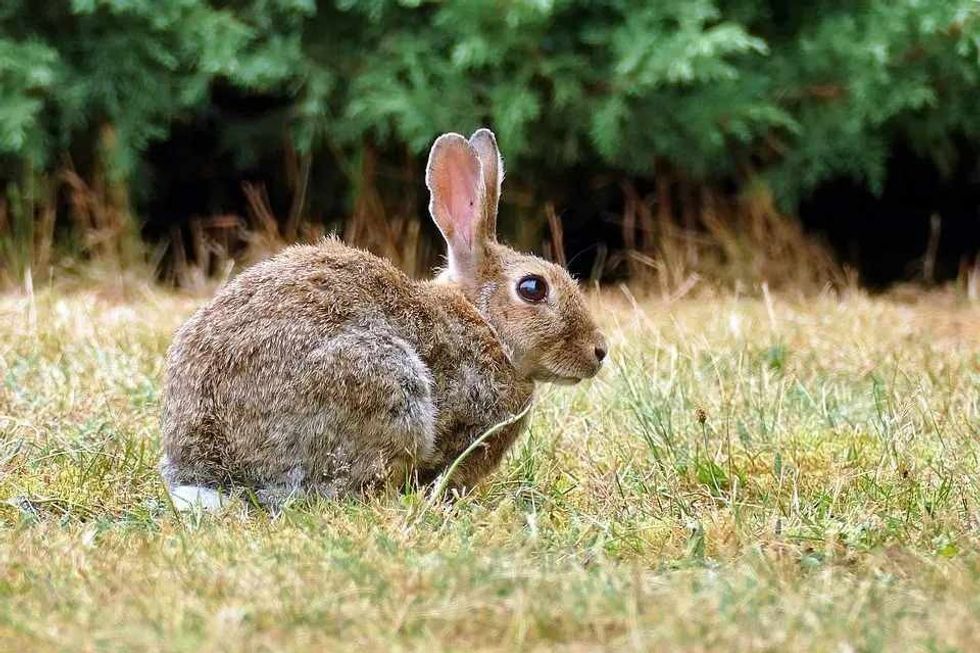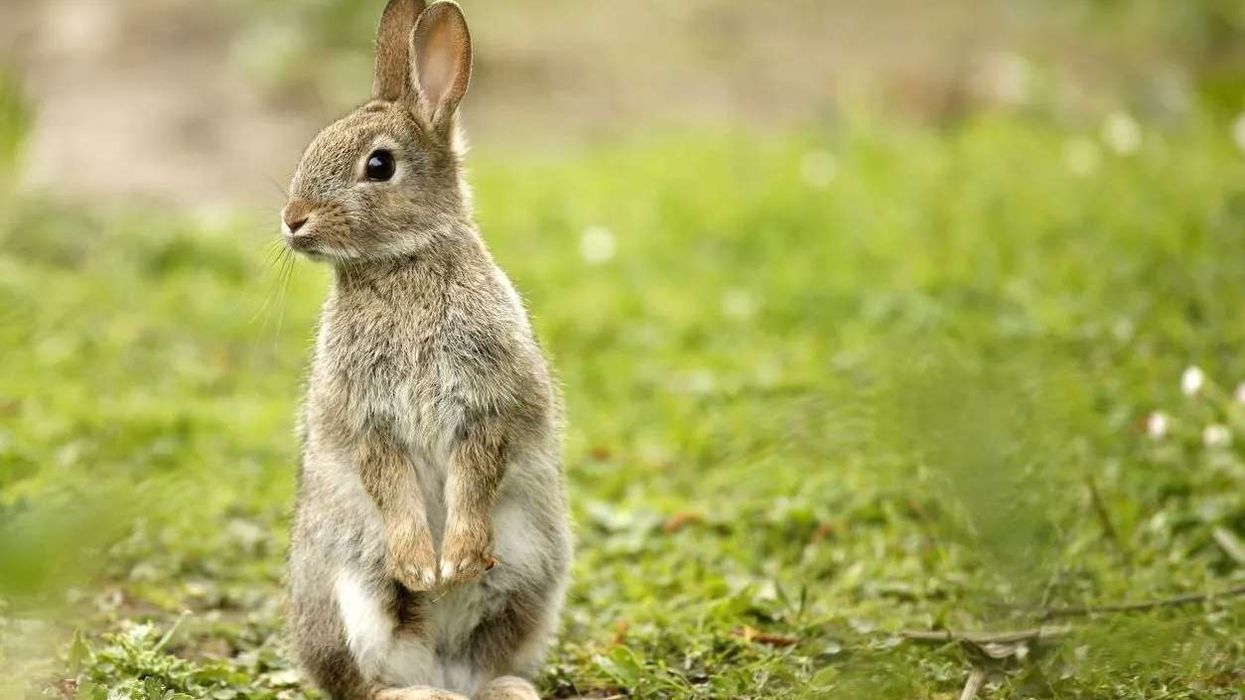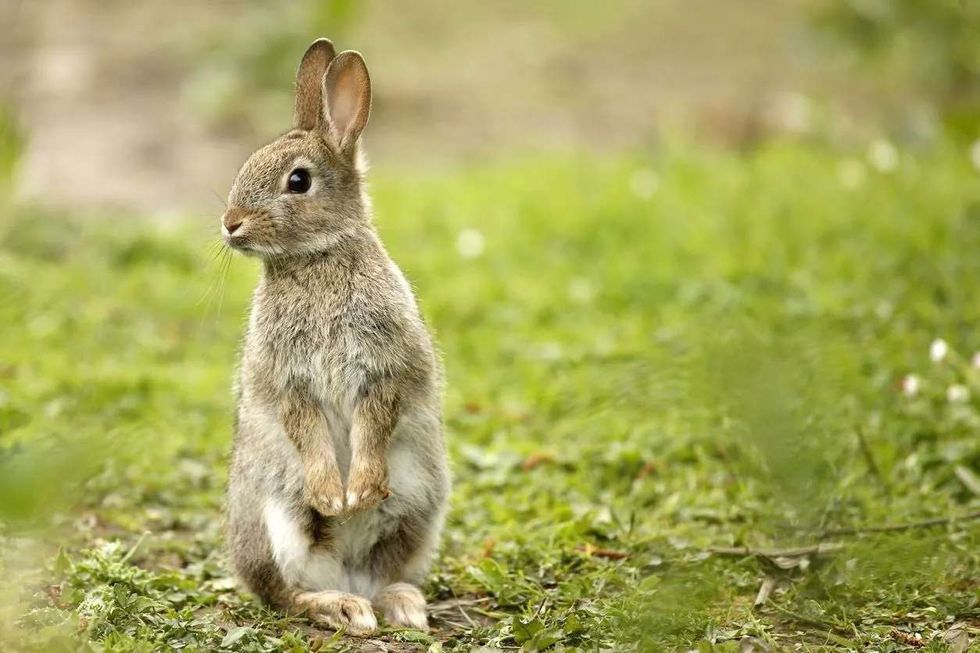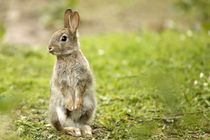Fun European Rabbit Facts For Kids

Content
- What type of animal is the European rabbit?
- What class of animal does the European rabbit belong to?
- How many European rabbits are there in the world?
- Where does the European rabbit live?
- What is the European rabbit's habitat?
- Who do European rabbits live with?
- How long do European rabbits live?
- How do they reproduce?
- What is their conservation status?
- What do European rabbits look like?
- How cute are they?
- How do they communicate?
- How big is the European rabbit?
- How fast can the European rabbit move?
- How much does the European Rabbit weigh?
- What are their male and female names of the species?
- What would you call a baby European rabbit?
- What do they eat?
- Are they dangerous?
- Would they make a good pet?
- Did you know...
- History of the European Rabbit
- Why is the European rabbit problematic?
European rabbits (Oryctolagus cuniculus)are smalls mammals belonging to the Iberian Peninsula in the countries of Spain, Portugal, the west of France and also to northwest African countries like Algeria and Morocco. These rabbits, despite being called European, have been introduced to and are now found on all continents, with the exception of Antarctica.
The Oryctolagus cuniculus predates domestic rabbits and is their ancestor. These rabbits can live for about nine years, provided they survive the first year.
European rabbits can cause damage to the environment if their population is in excess as they have a system of burrowing that is unique. Their tunnels, called warrens, are interwoven.
European rabbits are sociable animals. Therefore, they live in groups. The main focus of these groups are females as they do most of the work such as digging burrows and interweaving or linking them.
Dominance hierarchy is present between both males and females. In males, a dominance hierarchy is determined through access to the different females' burrows. In females, the dominance hierarchy is determined by the number of kits she can reproduce in her social group.
Below you can find more information and facts about these European rabbit breeds. If you would like to know some facts about similar species, also read our articles on mountain Hare and Fennec Fox.
European Rabbit Interesting Facts
What type of animal is the European rabbit?
The European rabbit (Oryctolagus cuniculus) or coney is a rabbit native to Europe from which it derived its name.
The European rabbit lives in burrows called warrens in a group of 6-10 individuals. These so-called warrens have many entry and exit doors. They usually live in groups for a successful breeding process.
The rabbits' maturation depends on their territoriality and aggressive behavior for the community's survival. Often, females are more territorial than males. Rabbits mark their territorial areas with dung hills.
Although their living area size depends on the type of habitat, food, protection from predators, and breeding sites, the territorial area generally comprises 0.7-1.7 acres (0.3-0.7 hectares). To find food, it rarely travels far from its burrows. It maintains a minimum distance of 82-164 ft (25-50 m).
If any environmental change such as harvesting in that area or threat from increasing predators, they might move as far as 1,640 ft (500 m) or two or three times further from their current habitat.
What class of animal does the European rabbit belong to?
European rabbits belong to the Mammalia class of the Leporidae family, which also includes hares. Its scientific name is 'Oryctolagus cuniculus.'
How many European rabbits are there in the world?
The Oryctolagus cuniculus population is estimated to be around 200 million just in Australia. While their exact population in Europe is not known, their density of population ranges from 0.5-10 rabbits in the range of 0.6 mi (1 km).
This animal is found worldwide, with the exception of Antarctica, due to human intervention. Many call native European rabbit invasive species because it was introduced to all continents except Antarctica.
Where does the European rabbit live?
The European rabbit, (Oryctolagus cuniculus) lives in dry areas, grasslands, some forests, and places near human settlements.
What is the European rabbit's habitat?
European rabbits live in burrows, also called 'warrens,' which they build near feeding areas. If the soil is loose, they build their burrows around trees with the roots as supporting structures. The burrow systems, size, and distribution depend on the soil's type and quality.
The 'Oryctolagus cuniculus' rabbit species is nocturnal and spent most of the daytime in their burrow systems. They come out in the evening and look out for food until daybreak.
European rabbits dig the burrows with their front legs and throw away the soil with their hind legs. The kits sleep inside the chambers filled with grass, and the adult rabbits sleep on bare earth.
The common rabbit, European rabbit, and other rabbit species quickly adapted to any habitat. All they need is soil for burrowing and good grass to feed.
Who do European rabbits live with?
European rabbits are interactive animals and live in social groups. If the soil permits, they create colonies within the burrow systems. Each such colony has around 6-10 adults of either gender.
How long do European rabbits live?
European rabbits, which are well known scientifically as Oryctolagus cuniculus, have an average lifespan of nine years in the wild. However, this species' mortality rate is 90% in the first year.
How do they reproduce?
European rabbits reach reproductive age in just 4-5 months after birth and continue breeding for another six years. The breeding season is generally between January to August. During this season, females reproduce multiple times. The gestation period is 30 days, and after this, the female rabbit produces a litter size of 3-7.
The sexual maturity of the kits is attained after four months. One of the exciting facts is that the rabbits can mate immediately after giving birth.
What is their conservation status?
The European rabbit (Oryctolagus Cuniculus) population has declined steadily since the 19th and early 20th centuries due to excessive hunting. This species is now categorized as 'Near Threatened with Extinction' in Native Europe, from where it originated. It has been put under the Endangered category by IUCN Red List.
European rabbit Fun Facts
What do European rabbits look like?

The European rabbit is one of the rabbit species. They have short front legs and long powerful hind legs. They have long ears, an adaptation for detecting predators, and large, slightly protruding eyes that give them broad, far-reaching vision.
The 'Oryctolagus cuniculus' has different body colors, from light brown to dark grayish to black. Such variety is chiefly based upon the number of guard hairs proportional to fur. Melanism is common in Europe, though abnormally white is rare.
The fur of the European rabbit is usually grayish-brown, but this may vary. The guard hairs are lined with brown, black, or gray. The neck and the scrotal sac are red, the chest part is brown, and the underparts are either white or gray.
When kits, they have a white star shape on their foreheads. But as they grow up, it rarely occurs, and in some, it disappears.
The feet are fully furred and yellowish-beige in color. Like cats, they have long black whiskers. They have a tail similar to the body color, which becomes more prominent when escaping danger.
The 'Oryctolagus cuniculus' is endothermic. The fur of European rabbits prevents them from overheating during the summer and freezing in the winter.
How cute are they?
European rabbits are cute medium-sized animals with soft thick fur to protect them from extreme climatic conditions. Their coat color varies from grayish brown to black to dark gray, and long and upright.
The 'Oryctolagus cuniculus' has a fragile body. Their bones are exceptionally delicate, and they can quickly get hurt. The 'Oryctolagus cuniculus' can be the best soft and fluffy creature with a tiny nose and whiskers.
How do they communicate?
European rabbits are nocturnal animals, meaning they stay in their burrows during the day and search for their food from evening till morning.
European rabbits emit high-pitched sounds during any danger as a distress call. They also make grunting sounds during the breeding season to attract other rabbits. The grunting sound is made with their mouth closed.
European rabbits often communicate with their fellow members through scent or touch. European rabbits are known to thump their hind limbs hard on the ground to warn of approaching danger.
How big is the European rabbit?
The average length of the European rabbit is between 14-20 in (38-51 cm). The 'Oryctolagus cuniculus' is two times smaller than the mountain hare.
How fast can the European rabbit move?
On average, a European Rabbit can run as fast as 25 miles/hr.
How much does the European Rabbit weigh?
The rabbit's size and weight vary according to food and habitat quality. An adult European Rabbit (Oryctolagus cuniculus) weighs around 3.30 - 5.51 lb (1.5 -2.5 kg). The wild baby rabbits weigh about 1.1-1.2 oz (31-34 g) and grow up to 4.8-6.4 oz (136-181 g) by 21–25 days. They are twice bigger than Eastern cottontail rabbits.
If there are fewer rabbits in a social group and good quality food is available, then males grow larger than females.
What are their male and female names of the species?
The male European rabbit is referred to as buck, and the female European rabbit is referred to as doe.
What would you call a baby European rabbit?
The baby of European rabbit is called bunny or kit.
What do they eat?
European rabbits are herbivores and eat grass and other root vegetation. They are known to choose the most nutritious part of the plant though they are not fussy eaters.
During the summer season, they are known to eat short grass to avoid predators. In winters, they prefer other abundantly available vegetation. A hungry rabbit is also known to eat tree bark during the winter season.
In case of scarcity of food, wild rabbits only eat the plant's parts high in nitrogen content. However, the European rabbit is not a fussy eater like the brown hare. European rabbits eat the whole root vegetables, while the brown hare leaves the root vegetable peels.
Are they dangerous?
European rabbits are not dangerous to humans. But they threaten the existing bio-diversity when introduced into new habitats by humans. Since they build burrows to live, which may cause soil erosion, an increase in the rabbit population might threaten the vegetation around.
Would they make a good pet?
As a non-domesticated species, these rabbit populations are not meant to be pets. European rabbits are less friendly when it comes to people. They quickly get scared and become cautious in the presence of humans. If raised in confinement, it might shorten their lifespan. However, the European rabbits are social when interacting with other breed members.
Did you know...
The Oryctolagus cuniculu' is the ancestor of approximately 80 different domestic rabbit breeds.
Adult European rabbits (Oryctolagus cuniculus) are smaller than the European hare and mountain hare.
European rabbit kittens are born blind and deaf with a complete bare body. The ears do not move until 10 days of age.
Male European rabbits are larger than females.
The molting or shedding in rabbits occurs on the face and back in March. The underfur is replaced between October-November.
European rabbits have a different type of brownish-grey coat that helps them survive during rough, icy climatic conditions.
European rabbits can run faster than humans.
The rabbits' ears can be rotated to an almost full circle of 270 degrees.
The health threats to European rabbits (Oryctolagus cuniculus) include virus myxomatosis, viral hemorrhagic disease, and rabbit calicivirus.
History of the European Rabbit
Humans introduced the European rabbit to all of its present non-native habitats. In 1859, the European rabbit in Australia was deliberately introduced by the European settlers into the wild to use them for food and hunting purposes.
European rabbits were sent to Australia as a gift to a wealthy settler, Thomas Austin, for hunting purposes. Around 13 rabbits were shipped to Victoria, Australia, by boat.
Thomas Austin let them roam freely in his estate. Unfortunately for the continent, there were males and females in this shipment, leading to the increase in the European rabbit population in Australia.
European rabbits are known to be invasive species because they have been introduced to the wild on all the continents, except Antarctica. As there was a lack of natural predators, they have caused many environmental problems, particularly European rabbits in Australia, which caused a devastating impact on biodiversity.
As these rabbits are well known for their adaptive nature and can reproduce rapidly, they spread in millions across the continent within years. Due to their large number, they contributed to Australian croplands' decline by overgrazing and burrowing. They also caused severe soil erosion and impacted native species that depend on ecosystems.
Why is the European rabbit problematic?
European rabbits are considered problematic because they are aggressive food searchers and negatively affect biodiversity. The lack of natural predators can affect the human habitat.
Though they are threatened species in their native land, ironically, they threaten crops. The building of burrows causes soil erosion, and continuous breeding habit is causing a surge in their population, threatening the vegetation in and around their burrows.
The introduction of the European rabbits in Australia led to the spread of this species like wildfire. European rabbits, in their native land, had the fox and wolf to hunt them down for food.
But in Australia, the cattle and local sheep ranchers themselves kept a check on the Tasmanian Wolf and the Dingo (the rabbit's primary hunters for food) to protect their cattle.
So, European rabbits had a chance to outgrow their population with no threat of predators for survival. The increasing number of these European rabbits, in turn, posed a threat to that region's habitat in Australia.
Here at Kidadl, we have carefully created lots of interesting family-friendly animal facts for everyone to discover! Learn more about some other mammals including stoat, or coati.
You can even occupy yourself at home by drawing one on our European Rabbit coloring pages.
We Want Your Photos!
More for You
Sources
https://en.wikipedia.org/wiki/European_rabbit
https://animaldiversity.org/accounts/Oryctolagus_cuniculus/
https://animalia.bio/european-rabbit
https://www.iucnredlist.org/species/41291/170619657
https://www.europarl.europa.eu/doceo/document/E-8-2017-003429_EN.html
https://www.rabbitcaretips.com/how-fast-do-rabbits-run/
https://www.ceenta.com/news-blog/4-animals-and-their-incredible-ears
See All
Master of Computer Science

Abhijeet ModiMaster of Computer Science
An experienced and innovative entrepreneur and creative writer, Abhijeet holds a Bachelor's and Master's degree in Computer Application from Birla Institute of Technology, Jaipur. He co-founded an e-commerce website while developing his skills in content writing, making him an expert in creating blog posts, website content, product descriptions, landing pages, and editing articles. Passionate about pushing his limits, Abhijeet brings both technical expertise and creative flair to his work.
Bachelor of Arts specializing in English Literature

Deeti GuptaBachelor of Arts specializing in English Literature
A detail-oriented fact-checker with a research-oriented approach. Devika has a passion for creative writing, she has been published on multiple digital publishing platforms and editorials before joining the Kidadl team. Currently pursuing a Bachelor of Arts in English Literature from St.Xavier's College, Deeti has won several accolades and writing competitions throughout her academic career.
Disclaimer
1) Kidadl is independent and to make our service free to you the reader we are supported by advertising. We hope you love our recommendations for products and services! What we suggest is selected independently by the Kidadl team. If you purchase using the Buy Now button we may earn a small commission. This does not influence our choices. Prices are correct and items are available at the time the article was published but we cannot guarantee that on the time of reading. Please note that Kidadl is a participant in the Amazon Services LLC Associates Program, an affiliate advertising program designed to provide a means for sites to earn advertising fees by advertising and linking to Amazon. We also link to other websites, but are not responsible for their content.
2) At Kidadl, we strive to recommend the very best activities and events. We will always aim to give you accurate information at the date of publication - however, information does change, so it’s important you do your own research, double-check and make the decision that is right for your family. We recognise that not all activities and ideas are appropriate for all children and families or in all circumstances. Our recommended activities are based on age but these are a guide. We recommend that these ideas are used as inspiration, that ideas are undertaken with appropriate adult supervision, and that each adult uses their own discretion and knowledge of their children to consider the safety and suitability. Kidadl cannot accept liability for the execution of these ideas, and parental supervision is advised at all times, as safety is paramount. Anyone using the information provided by Kidadl does so at their own risk and we can not accept liability if things go wrong.
3) Because we are an educational resource, we have quotes and facts about a range of historical and modern figures. We do not endorse the actions of or rhetoric of all the people included in these collections, but we think they are important for growing minds to learn about under the guidance of parents or guardians.







